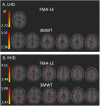Stroke Lesion Impact on Lower Limb Function
- PMID: 33597852
- PMCID: PMC7882502
- DOI: 10.3389/fnhum.2021.592975
Stroke Lesion Impact on Lower Limb Function
Abstract
The impact of stroke on motor functioning is analyzed at different levels. 'Impairment' denotes the loss of basic characteristics of voluntary movement. 'Activity limitation' denotes the loss of normal capacity for independent execution of daily activities. Recovery from impairment is accomplished by 'restitution' and recovery from activity limitation is accomplished by the combined effect of 'restitution' and 'compensation.' We aimed to unravel the long-term effects of variation in lesion topography on motor impairment of the hemiparetic lower limb (HLL), and gait capacity as a measure of related activity limitation. Gait was assessed by the 3 m walk test (3MWT) in 67 first-event chronic stroke patients, at their homes. Enduring impairment of the HLL was assessed by the Fugl-Meyer Lower Extremity (FMA-LE) test. The impact of variation in lesion topography on HLL impairment and on walking was analyzed separately for left and right hemispheric damage (LHD, RHD) by voxel-based lesion-symptom mapping (VLSM). In the LHD group, HLL impairment tended to be affected by damage to the posterior limb of the internal capsule (PLIC). Walking capacity tended to be affected by a larger array of structures: PLIC and corona radiata, external capsule and caudate nucleus. In the RHD group, both HLL impairment and walking capacity were sensitive to damage in a much larger number of brain voxels. HLL impairment was affected by damage to the corona radiata, superior longitudinal fasciculus and insula. Walking was affected by damage to the same areas, plus the internal and external capsules, putamen, thalamus and parts of the perisylvian cortex. In both groups, voxel clusters have been found where damage affected FMA-LE and also 3MWT, along with voxels where damage affected only one of the measures (mainly 3MWT). In stroke, enduring 'activity limitation' is affected by damage to a much larger array of brain structures and voxels within specific structures, compared to enduring 'impairment.' Differences between the effects of left and right hemisphere damage are likely to reflect variation in motor-network organization and post-stroke re-organization related to hemispheric dominance. Further studies with larger sample size are required for the validation of these results.
Keywords: activity limitation; brain mapping; compensation; impairment; lower extremity; restitution; stroke.
Copyright © 2021 Frenkel-Toledo, Ofir-Geva, Mansano, Granot and Soroker.
Conflict of interest statement
The authors declare that the research was conducted in the absence of any commercial or financial relationships that could be construed as a potential conflict of interest.
Figures



References
-
- Barber A. D., Srinivasan P., Joel S. E., Caffo B. S., Pekar J. J., Mostofsky S. H. (2012). Motor “dexterity”: evidence that left hemisphere lateralization of motor circuit connectivity is associated with better motor performance in children. Cereb. Cortex 22 51–59. 10.1093/cercor/bhr062 - DOI - PMC - PubMed
-
- Brodal P. (2016). The Central Nervous System. 5th Edn New York, NY: Oxford UP.
LinkOut - more resources
Full Text Sources
Other Literature Sources

